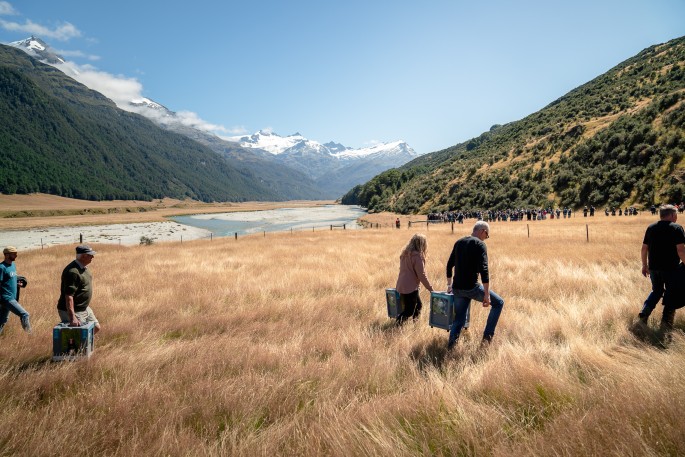This Content Is Only For Subscribers
Efforts to expand a wild population of takahē near Queenstown began on February 11 with the release of 18 birds in the Rees Valley.
After travelling from Burwood Takahē Centre near Te Anau and Orokonui Ecosanctuary Dunedin, takahē rangers paused briefly at Glenorchy Primary School for children to wave the birds on to the release site.
Mana whenua Ngāi Tahu welcomed takahē with a mihi whakatau before they were released.
The decision to release takahē into the Rees Valley was made after takahē released into Greenstone Valley in 2023 showed early signs of successfully adjusting to their new environment – raising offspring and remaining in a healthy condition.
Thought to be extinct for 50 years, takahē are a taonga of Ngāi Tahu, unique to New Zealand and the largest flightless species of rail bird in the world. They were famously rediscovered in the Murchison Mountains in 1948.
DOC’s Takahē recovery senior ranger Glen Greaves says existing wild sites in the Murchison Mountains and the Greenstone Valley are reaching capacity, so the focus is now on establishing more wild populations elsewhere.
“Finding wild sites with the right habitat, and with predator numbers low enough for takahē to thrive is a challenge – but the Greenstone, Rees, and wider Whakatipu areas likely provide high-quality habitat for takahē.”
Glen says predator control has been a significant factor in ensuring the translocation can go ahead. However, like other large wild sites, predator threats and dispersal into less-protected areas remain.
“Setting up new wild populations takes perseverance, and success is not guaranteed,” says Glen.
“We hope people walking the Rees-Dart track and Routeburn tracks will soon have a good chance of seeing takahē thriving in their natural wild habitat.”
Ngāi Tahu representative on the Takahē Recovery Group, Gail Thompson says the release of takahē into the Rees Valley is a welcome next step towards the goal of increasing the number of takahē roaming free in the wild.
“It is my hope the manu will thrive in this valley as they have so far in the Greenstone Valley and that current and future generations will have the opportunity to see takahē in their natural environment.
“Our tīpuna inhabited the valley to the west of Puahiri/Puahere awa/Rees River and this whenua was part of a well-known network of ara tawhito/trails to pounamu sources. It is heartening that these takahē can now make this place their home,” says Gail.
Today the total takahē population is more than 500 and growing at about five percent a year. More than half the birds now live at wild sites.
Kaiwhakahaere/co-chair of Southern Lakes Sanctuary, Greg Lind, says their organisation’s work has been to prepare the Rees Valley for takahē to hopefully thrive upon their return to this special area.
“We have been servicing a network of more than 500 traps in suitable takahē habitats and have been focused on intensive feral cat control,” says Greg.
“This takahē release is a great example of the power of collaboration, with each party making vital contributions to make this a reality. This includes everyone from donors, iwi, landowners, community groups and DOC.”
A further two takahē releases into the Rees Valley are planned for later this year, with the aim of establishing a population of up to 80 takahē in the Rees Valley in 2025.
DOC’s Takahē Recovery Programme, supported by National Partner Fulton Hogan and New Zealand Nature Fund, together with Ngāi Tahu and Southern Lakes Sanctuary have been working together to create one large self-sustaining population of takahē in the Upper Whakatipu – with the shared goal of restoring takahē to whenua they likely inhabited centuries ago.



